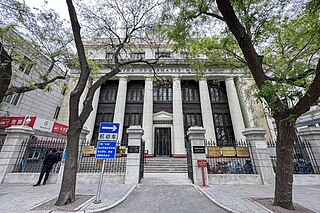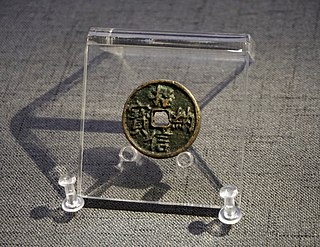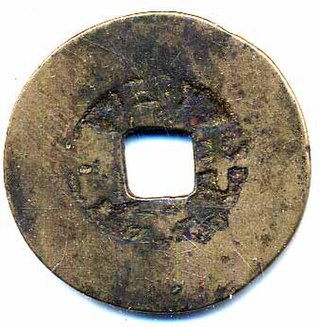Related Research Articles

Numismatics is the study or collection of currency, including coins, tokens, paper money, medals and related objects.

Chinese coinage in the Ming dynasty saw the production of many types of coins. During the Ming dynasty of China, the national economy was developed and its techniques of producing coinage were advanced. One early period example is the Bronze 1 cash. Obverse: "Hongwu Tongbao" (洪武通寶). Reverse: blank. Average 23.8 mm, 3.50 grams.
Silk Road Numismatics is a special field within Silk Road studies and within numismatics. It is particularly important because it covers a part of the world where history is not always clear – either because the historical record is incomplete or is contested. For example, numismatics has played a central role in determining the chronology of the Kushan kings.
The Liao dynasty was a Khitan-led dynasty of China that ruled over parts of Northern China, Manchuria, the Mongolian Plateau, northern Korean Peninsula, and what is modern-day Russian Far East from 916 until 1125 when it was conquered by the Jin dynasty. Remnants of the Liao court fled westward and created the Western Liao dynasty which in turn was annexed by the Mongol Empire in 1218.
Helen Kay Wang is an English sinologist and translator. She works as curator of East Asian Money at the British Museum in London. She has also published a number of literary translations from Chinese, including an award-winning translation of a Chinese children's book.

The China Numismatic Museum is a museum about currency in Beijing, China.

Horse coins, alternatively dama qian (打馬錢), are a type of Chinese numismatic charm that originated in the Song dynasty and presumed to have been used as gambling tokens. Although many literary figures wrote about these coins their usage has always been failed to be mentioned by them. Most horse coins tend to be round coins, 3 centimeters in diameter with a circular or square hole in the middle of the coin. The horses featured on horse coins are depicted in various positions such as lying asleep on the ground, turning their head while neighing, or galloping forward with their tails rising high. it is currently unknown how horse coins were actually used though it is speculated that Chinese horse coins were actually used as game board pieces or gambling counters. Horse coins are most often manufactured from copper or bronze, but in a few documented cases they may also be made from animal horns or ivory. The horse coins produced during the Song dynasty are considered to be those of the best quality and craftsmanship and tend be made from better metal than the horse coins produced after. Some horse coins would feature the name of the famous horses they depicted. It is estimated that there are over three hundred variants of the horse coin. Some horse coins contained only an image of a horse while others also included an image of the rider and others had inscriptions which identify the horse or rider. During the beginning of the year of the horse in 2002 Chinese researchers Jian Ning and Wang Liyan of the National Museum of Chinese History wrote articles on horse coins in the China Cultural Relics Newspaper, noting that they found it a pity that the holes in the coins covered the saddles of the horses as this could have revealed more about ancient horse culture. Horse coins from the Song dynasty are the horse coins that are produced at the highest quality while horse coins from subsequent dynasties tend to be inferior compared to them.
Werner Burger was a German numismatist specialising in Chinese coins of the Qing dynasty (1644–1911). He wrote the first PhD on Chinese numismatics.
The China Numismatic Society is a society focusing on numismatics in the People's Republic of China, with its secretariat in the China Numismatic Museum in Beijing.
Numismatic associations bring together groups of numismatists. They may be commercial, hobby or professional. Membership is sometimes by election.

The Kaiyuan Tongbao, sometimes romanised as Kai Yuan Tong Bao or using the archaic Wade-Giles spelling K'ai Yuan T'ung Pao, was a Tang dynasty cash coin that was produced from 621 under the reign of Emperor Gaozu and remained in production for most of the Tang dynasty until 907. The Kaiyuan Tongbao was notably the first cash coin to use the inscription tōng bǎo (通寶) and an era title as opposed to have an inscription based on the weight of the coin as was the case with Ban Liang, Wu Zhu and many other earlier types of Chinese cash coins. The Kaiyuan Tongbao's calligraphy and inscription inspired subsequent Central Asian, Japanese, Korean, Ryūkyūan, and Vietnamese cash coins and became the standard until the last cash coin to use the inscription "通寶" was cast until the early 1940s in French Indochina.
Luo Bozhao was a Chinese numismatist. He was also known as Wenjiong (文炯), Muyuan (沐園) and P. C. Low.
François Thierry de Crussol is a French numismatist, specialising in East Asian currency..

Vault Protector coins were a type of Chinese numismatic charm coins created by Chinese mints. These coins were significantly larger, heavier and thicker than regular cash coins and were well-made as they were designed to occupy a special place within the treasury of the mint. The treasury had a spirit hall for offerings to the gods of the Chinese pantheon, and Vault Protector coins would be hung with red silk and tassels for the Chinese God of Wealth. These coins were believed to have charm-like magical powers that would protect the vault while bringing wealth and fortune to the treasury.

The Zhaona Xinbao is a special type of Southern Song dynasty cash coin developed as a propaganda and psychological warfare tool for recruiting defectors from the army of the Jurchen Jin dynasty around the year Shaoxing 1 under the reign of Emperor Gaozong. These special coins superficially resemble traditional Chinese cash coins but contain an inscription alluding to their intent, generally these Zhaona Xinbao tokens were made from bronze but in very rare cases they were also made from silver or gold.

The Da-Qing Tongbi, or the Tai-Ching-Ti-Kuo copper coin, refers to a series of copper machine-struck coins from the Qing dynasty produced from 1906 until the fall of the Qing dynasty in 1911. These coins were intended to replace the earlier cast cash coins and provincial coinages, but were welcomed to mixed receptions.

Bingqian, or Bingxingqian, is a term, which translates into English as "biscuit coins", "pie coins", or "cake coins", used by mainland Chinese and Taiwanese coin collectors to refer to cash coins with an extremely broad rim as, these cash coins can also be very thick. While the earliest versions of the Bingqian did not extraordinarily broad rims.
References
- ↑ "Lyce Jankowski | Numismatic Who's Who CoinsWeekly". coinsweekly.com. Retrieved 2018-07-25.
- ↑ Les cercles de collectionneurs et de numismates dans la région de Pékin durant la première moitié du XIXème siècle
- ↑ "L'Équipe du Musée".
- ↑ AIBL (2018-11-22). "Lauréats 2018". aibl.fr (in French). Retrieved 2019-12-09.
- ↑ "Les Amis des monnaies - La sociabilité savante des collectionneurs et numismates chinois de la fin des Qing". hemisphereseditions.com. Retrieved 2018-12-30.
- ↑ F. Thierry, "CR de Jankowski Lyce, Les Amis des monnaies, La sociabilité savante des collectionneurs et numismates chinois de la fin des Qing, Paris, Maisonneuve & Larose/Hémisphères 2018", Revue Numismatique 177 (2020), pp. 429-433.
- ↑ "American Journal of Numismatics 30". numismatics.org. Retrieved 2018-12-30.
- ↑ Lyce, Jankowski (何淑真); 张亚威; 孟祥伟 (November 2019). "美国钱币学会收藏中国钱币的历史(上)". 中国钱币. 160 (5): 16–25. doi:10.13850/j.cnki.chinum.2019.05.003.
- ↑ Lyce, Jankowski (何淑珍); 张亚威; 孟祥伟 (December 2019). "美国钱币学会收藏中国钱币的历史(下)". 中国钱币. 161 (6): 8–20. doi:10.13850/j.cnki.chinum.2019.06.002.
- ↑ "HISTORIA MUNDI- 4° NUMERO- 17/11/2014 - Bibliografia numismatica, riviste e novita' editoriali - Lamoneta.it - Numismatica, monete, collezionismo". lamoneta.it. Retrieved 2018-07-25.